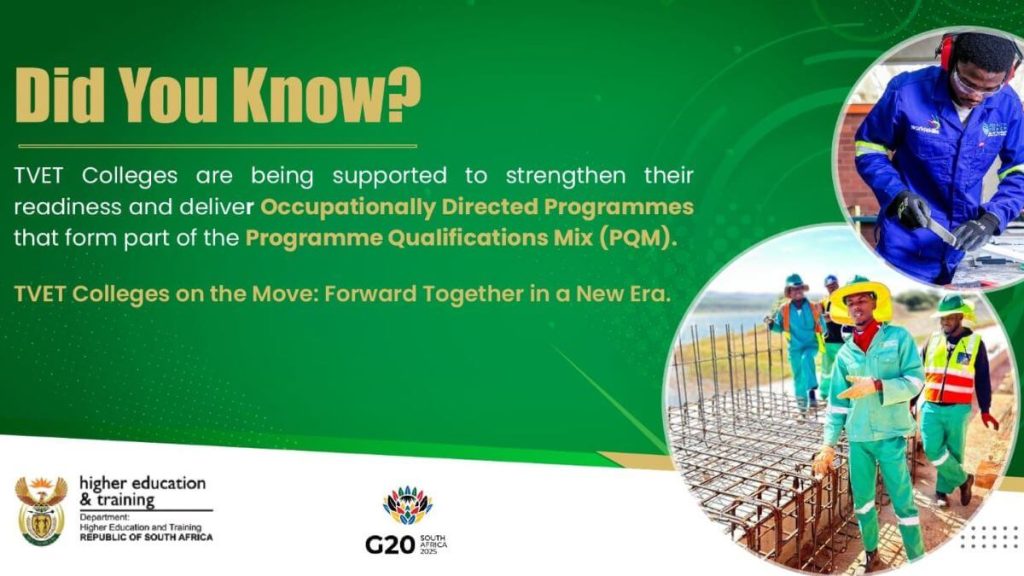South Africa’s economy stands at a crossroads, with unemployment rates among the highest globally and youth disproportionately affected. At the heart of this challenge is the need to align education with industry, ensuring that graduates not only hold certificates but also possess practical skills that make them employable. For decades, Technical and Vocational Education and Training (TVET) colleges have offered the NATED N4–N6 programmes, which provided a pathway for students seeking technical skills. While these programmes played an important role in the past, their limitations became increasingly clear in the modern world.
Today, South Africa is embarking on a bold reform to reposition TVET colleges. The Department of Higher Education and Training (DHET), in collaboration with Sector Education and Training Authorities (SETAs), employers, and global partners, is moving towards Occupational Qualifications — programmes that are designed by industry experts and directly linked to workplace needs. This is not a small adjustment; it is a fundamental transformation of how the country prepares its youth for the labour market.
The objective of this reform is simple yet ambitious: to produce graduates who are job-ready, entrepreneurial, and able to adapt to emerging sectors such as renewable energy, information technology, logistics, and advanced manufacturing. With South Africa hosting the G20 Summit in 2025, the message is clear: investing in skills is the foundation of inclusive growth, and TVET colleges are central to this vision.
Understanding TVET in South Africa
TVET colleges are part of the post-school education and training system, catering to students who seek practical qualifications outside of traditional universities. There are currently 50 public TVET colleges with more than 260 campuses spread across the country. These institutions enrol hundreds of thousands of students annually, making them a critical driver of youth development.
Historically, TVET colleges have offered the NATED (National Accredited Technical Education Diploma) programmes, structured in levels from N1 to N6. These programmes covered fields such as engineering, business studies, and hospitality. They were mostly theory-driven, supplemented by some practical elements, and designed to prepare students for technician-level roles. However, a major gap emerged: employers often complained that graduates lacked the hands-on experience required in the workplace.
South Africa’s TVET system has long faced three key challenges:
Curriculum relevance: Many programmes lagged behind industry needs, failing to keep up with technological changes.
Stigma: TVETs were often viewed as a “second-choice” option compared to universities.
Employability: Graduates often struggled to secure work, feeding into the country’s unemployment crisis.
These issues highlighted the need for a new direction. As global economies moved towards skills-based education systems, South Africa realised that its vocational programmes required a radical redesign.
From NATED to Industry-Driven Qualifications: Why the Shift?
The NATED system has been in place since the 1960s. While it helped create a pool of technicians and artisans, it is no longer sufficient in addressing the needs of a rapidly changing economy. Employers require workers who are not only academically trained but also practically competent from day one.
Shortcomings of the NATED Programmes
Outdated curriculum content.
Heavy reliance on theory rather than practice.
Limited industry input in qualification design.
Inflexible structure that did not cater to new sectors such as ICT, renewable energy, or logistics.
The Promise of Occupational Qualifications
The shift towards Occupationally Directed Qualifications is meant to address these gaps. Unlike NATED, these qualifications are designed in close partnership with industries and SETAs. They emphasise work-integrated learning (WIL), apprenticeships, and internships, ensuring students gain hands-on training alongside classroom theory.
The Programme Qualifications Mix (PQM) forms the foundation of this transition. It outlines a balanced offering of occupational, vocational, and higher-level qualifications, ensuring that colleges are responsive to both local and global labour demands.
This shift aligns with several national and international goals:
South Africa’s National Development Plan (NDP) 2030: Focuses on reducing youth unemployment through skills.
National Skills Development Plan (NSDP): Prioritises occupational training as a driver of growth.
G20 2025 Agenda: Emphasises youth employability and digital readiness.
Government Policy and Support for Reform
The DHET has placed TVET colleges at the centre of national skills development. Key reforms include:
Curriculum Modernisation: Phasing out NATED and introducing new occupational qualifications across engineering, ICT, construction, and business.
Funding: Expanded support through NSFAS bursaries, SETA grants, and targeted government funding for priority skills sectors.
Lecturer Development: Training programmes for lecturers to adapt to new qualifications, including short courses, workplace exposure, and professional certifications.
Infrastructure Investments: Upgrading workshops, laboratories, and digital infrastructure to match industry standards.
Partnership Models: Strengthening collaboration with employers for workplace training opportunities.
A notable development is the Centre of Specialisation (CoS) initiative, where select TVET colleges specialise in high-demand trades such as plumbing, electrical work, and mechanical engineering. These centres serve as models for how occupational qualifications should be implemented nationwide.
Industry Partnerships: Employers as Co-Designers of Qualifications
One of the most significant differences between NATED and occupational qualifications is industry involvement. Employers are no longer passive consumers of graduates; they are active partners in designing, implementing, and evaluating training programmes.
Role of SETAs
Sector Education and Training Authorities (SETAs) play a crucial role by bridging the gap between industry and education. They fund workplace learning, identify scarce skills, and ensure that qualifications match real market demands.
Examples of Collaboration
This reform is not theoretical. Across South Africa, TVET colleges are already working with industries to deliver real-world occupational programmes.
1. Engineering
South West Gauteng TVET College (SWGC) + WAL Training (Pty) Ltd: Offers three-year apprenticeships in trades such as electrician, fitter & turner, and welder, funded by Services SETA .
Ekurhuleni West TVET College + German bbw (dual model): Pilots mechatronics apprenticeships where students alternate between classroom and industry-based training, accredited by QCTO .
2. Construction and Modern Building Practices
Greening of Colleges Initiative (DHET): Pilot colleges such as Northlink and Central Johannesburg are integrating sustainable construction methods, energy efficiency, and green building practices into their curriculum .
TVET 4.0 Project: Expands solar photovoltaic occupational qualifications, requiring students to gain experience with construction-related tasks such as rooftop PV installation and wiring .
3. ICT and Technology
TVET colleges now offer short skills programmes in ICT, including coding, networking, and cybersecurity, to meet employer demand .
DHET’s TVET–Industry Partnership Framework highlights ICT as a priority area for collaboration, ensuring curriculum co-design with employers .
4. Renewable Energy and the Green Economy
EWSETA + CCIEEC + Multiple Colleges: Training lecturers and students in solar PV, batteries, and inverters, with learners from Elangeni and South West Gauteng colleges gaining experiential training in China .
Nkangala TVET College + Res4Africa: Upskilled lecturers in renewable energy through the RE-Skilling Lab initiative .
Hydrogen Fuel Cell Training: Thirty TVET lecturers trained in Pretoria to prepare institutions for South Africa’s green hydrogen economy .
Ehlanzeni TVET College + NAFBI: Launched a solar PV apprenticeship to address the national energy skills shortage.
Employers benefit from a pipeline of skilled workers, while students gain exposure and practical competence that enhances their employability.
Challenges in the New Era
Despite the progress, the reform journey is not without obstacles.
Funding Constraints: Many colleges struggle with budget limitations, affecting infrastructure upgrades and staff salaries.
Infrastructure Gaps: Outdated workshops and labs still exist in several rural campuses.
Lecturer Capacity: Not all lecturers are adequately prepared to deliver the new occupational qualifications.
Perceptions: The stigma around TVET colleges as “second-class” institutions persists.
Scalability: Rolling out occupational qualifications nationwide requires careful coordination and time.
As the DHET’s Project 6.1 research explains, “The ability to mediate classroom learning, institutional demands, and industry relevance defines the quality of a TVET lecturer.” This highlights the ongoing challenge of ensuring that lecturers receive the professional support and development they need to deliver high-quality, industry-responsive teaching.
Opportunities Ahead
While challenges exist, the transformation also opens exciting opportunities:
Digital TVETs: Incorporation of e-learning platforms, virtual labs, and blended learning.
Green Economy: Preparing artisans and technicians for renewable energy jobs.
Entrepreneurship Training: Equipping students not only for employment but also for starting businesses.
Women in TVET: Programmes to increase female participation in male-dominated trades.
Youth Empowerment: Providing pathways for school leavers, unemployed youth, and workers needing reskilling.
With South Africa’s economy needing a new generation of skilled workers, TVETs are positioned as hubs of innovation, training, and employment creation.
Case Studies: Success Stories from Colleges
Some colleges are already leading the way in adopting occupational qualifications.
Ekurhuleni West TVET College: Piloting renewable energy technician training in partnership with private companies.
False Bay TVET College: Running occupational programmes in boatbuilding and IT networking.
Majuba TVET College: Specialising in welding and mechanical engineering with strong employer ties.
Students in these pilot programmes report higher employment rates and greater confidence entering the workforce. Employers confirm that graduates demonstrate job-ready skills, reducing the need for costly retraining.
Global Comparisons
South Africa is not alone in reforming vocational education. Germany’s dual system, which combines classroom learning with apprenticeships, is considered a global benchmark. Countries like China and Singapore have also successfully built vocational systems aligned with industry. South Africa’s new occupational approach mirrors these models, focusing on work-integrated learning and industry co-design.
By adopting global best practices while addressing local realities, South Africa is positioning its TVET system as competitive in both regional and international labour markets.
The Way Forward: Building a Skilled, Inclusive Future
For TVET reform to succeed, stakeholders must continue working together. Key recommendations include:
Expand funding for infrastructure and bursaries.
Strengthen lecturer training to ensure teaching quality.
Scale up industry partnerships beyond urban centres to rural areas.
Raise awareness to change public perceptions of TVET.
Monitor and evaluate implementation to ensure impact.
The long-term goal is a future-ready South Africa where young people have access to practical, respected, and rewarding career pathways.
Also check: 2025 Matric Exam Timetable
Forward Together in a New Era
The transition from NATED to occupational qualifications marks the biggest reform in South Africa’s vocational education in decades. It is a shift that promises to produce graduates who are employable, adaptable, and entrepreneurial. More than that, it signals a new era for TVET colleges: one where they are no longer “second choice” institutions, but powerhouses of innovation and skills development.
As the slogan from DHET states, “TVET Colleges on the Move: Forward Together in a New Era.” This is not simply a policy reform; it is a national mission. The future of South Africa’s economy depends on the success of its TVET system, and with industry, government, and students working in unison, the vision of a skilled, inclusive, and future-ready nation is within reach.










